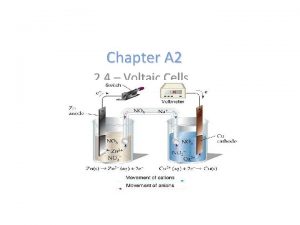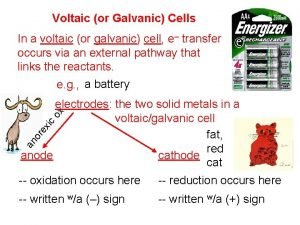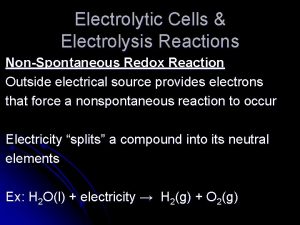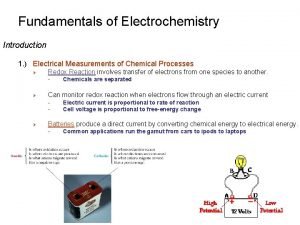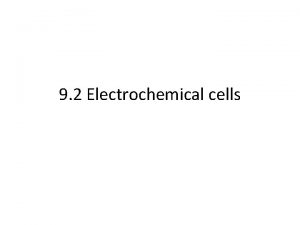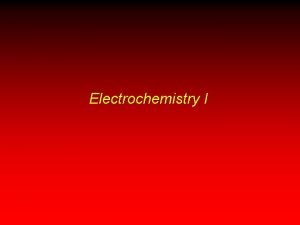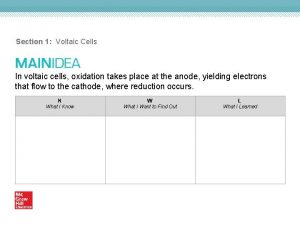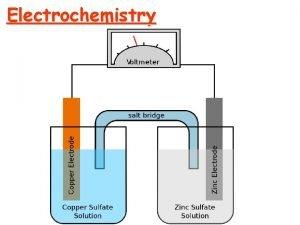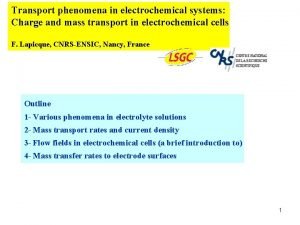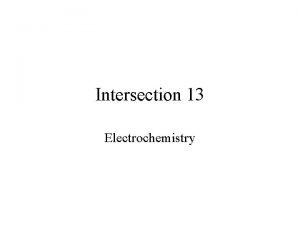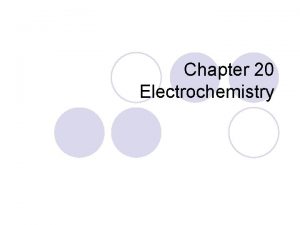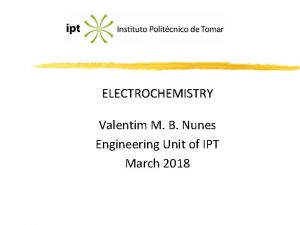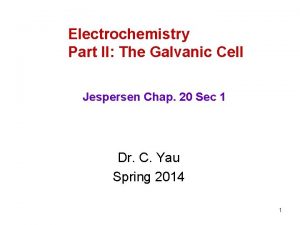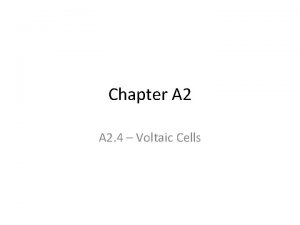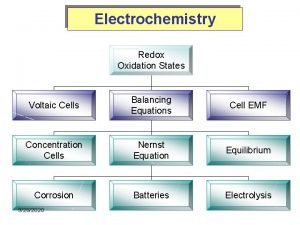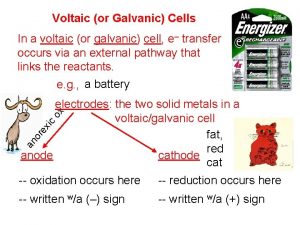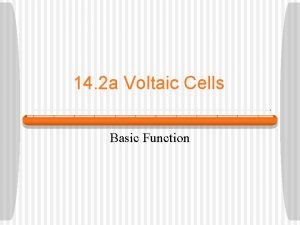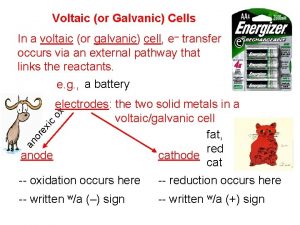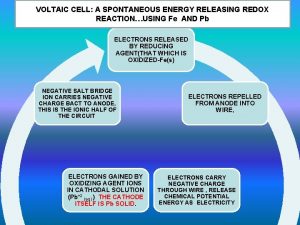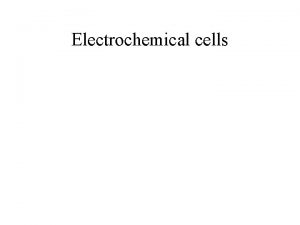Topic 9 19 Electrochemistry Voltaic Cells Spontaneous redox











































- Slides: 43

Topic 9 / 19 Electrochemistry

Voltaic Cells Spontaneous redox rxns can be used to generate an electric current. Half-reactions can be separated so that energy released during a reaction is available as electrical energy instead of being lost as heat. Half-reactions are separated into half-cells, allowing the electrons to flow between them only through an external circuit.

Half-cells A simple half-cell is a metal submerged in an aqueous sol’n of it’s own ions.

Half-cells In each half-cell, there is a charge separation (because the metal strip of atoms will form ions by releasing elections that make the surface of the metal negatively charged with respect to the solution), known as electrode potential. At the same time, ions in the sol’n gain electrons to form metal atoms, so an equilibrium exists. Zn half-cell: Zn 2+(aq) + 2 e-

Half-cells Consider the Zn/Cu battery… The eq’m position of each determines the size of the electrode potential in the halfcell and depends on the reactivity of the metal.

Half-cells Copper is the less reactive metal, so in its half-cell, the eq’m position lies further to the right; thus Cu has less of a tendency to lose electrons than Zn. Zn half-cell: Zn 2+(aq) + 2 e- Zn(s) Cu half-cell: Cu 2+(aq) + 2 e- Cu(s)

Half-cells Thus there are fewer electrons on the copper metal strip, so it will develop a larger (less negative) electrode potential than the zinc half-cell. Zn half-cell: Zn 2+(aq) + 2 e- Zn(s) -0. 76 V Cu half-cell: Cu 2+(aq) + 2 e- Cu(s) +0. 34 V

Diagram of a voltaic cell: zinc/copper When the copper and zinc half-cells are connected by an external wire, electrons will have a tendency to flow spontaneously from the zinc halfcell to the copper half-cell because of their different electrode potentials (a. k. a. potential difference). Zn(s) → Zn 2+(aq) + 2 e- Cu 2+(aq) + 2 e- → Cu(s)

Diagram of a voltaic cell: zinc/copper Obviously, there is a potential difference so why does the voltmeter have no reading? With no return to balance the solutions, voltage will come to a halt. One sol’n will become overly (+) and the other (-). Zn(s) → Zn 2+(aq) + 2 e- Cu 2+(aq) + 2 e- → Cu(s)

Diagram of a voltaic cell: zinc/copper So how do we restore the flow of electrons and the neutral status of the solutions? The circuit must be completed. Zn(s) → Zn 2+(aq) + 2 e- Cu 2+(aq) + 2 e- → Cu(s)

Diagram of a voltaic cell: zinc/copper A salt bridge allows the electrons to move without changing the overall charge of the sol’ns. Notice the reading now on the voltmeter matches the potential difference of the original half cells. Zn(s) → Zn 2+(aq) + 2 e- Cu 2+(aq) + 2 e- → Cu(s)

Diagram of a voltaic cell: zinc/copper But why? As electrons are stripped away from the Zn metal strip, the new formed cation is deposited into sol’n. Anions move from the bridge to balance the charge of the now growing (+) sol’n. Zn(s) → Zn 2+(aq) + 2 e- Cu 2+(aq) + 2 e- → Cu(s)

Diagram of a voltaic cell: zinc/copper But why? As electrons are placed on the Cu metal strip, cations from the sol’n start to attach to the metal strip. Cations move from the bridge to balance the charge of the now growing (-) sol’n. Zn(s) → Zn 2+(aq) + 2 e- Cu 2+(aq) + 2 e- → Cu(s)

Diagram of a voltaic cell: zinc/copper Through this process, the metal zinc strip is getting lower in mass while the metal copper strip is growing in mass. Zn(s) → Zn 2+(aq) + 2 e- Cu 2+(aq) + 2 e- → Cu(s)

Mnemonic device for you… Big fat red cat! The big fat # (greatest reduction potential) is the site of reduction (cathode)

Standard Electrode Potentials A voltaic cell generates an electromotive force (emf) as electrons flow from the half-cell with more negative potential to the half-cell with the more positive potential. Magnitude of voltage depends on the difference in the tendencies of these two half-cells to undergo reduction. Electrode potential of a single half-cell cannot

Standard Electrode Potentials Thus, to create a list of relative reducing powers of different half-cells, it is necessary to compare them all with some fixed reference point that acts as a standard for measurement.

Why do we need a standard? ? ? Analogy: heights of mountains can be compared with each other because each is given a height relative to an agreed zero point (sea level)

Standard Electrode Potentials Reference standard in electrochemistry = standard hydrogen electrode. H 2(g) 2 H+(aq) + 2 e The hydrogen half-cell is arbitrarily assigned electrode potential = 0 V This gives us a means to measure and compare the electrode potential of any other

Measuring standard electrode potentials Half-cells are connected with hydrogen electrode under standard conditons: Concentration of all sol’ns = 1. 0 mol dm-3 Pressure of all gases = 100 k. Pa All substances used must be pure Temp = 298 K / 25 C If half-cell does not include a solid metal, platinum (Pt) is used as the electrode.

Measuring standard electrode potentials Shorthand/line notation:

Calculations involving standard electrode potentials Keep the following in mind: All E values refer to the reduction rxn. The E value for the oxidation rxn will be of equal magnitude and opposite sign. The E values do not depend on the total number of electrons, so do not have to be scaled up or down according to the stoichiometry of the eq’n. The more positive the E value for a half-cell, the more readily it is reduced. More negative reduction potential = anode

1. Calculating the cell potential, E cell = E cathode - E anode E cell = E half-cell where reduction occurs - E half-cell where oxidation occurs Example: Calculate the emf for a voltaic cell constructed from a copper half-cell and a silver half-cell. E cell = +0. 80 V – (+0. 34 V) E cell = +0. 46 V

2. Determining spontaneity of a rxn – plug in values based on way rxn is written. Spontaneous if E cell = positive E cell = E half-cell where reduction occurs - E half-cell where oxidation occurs Example: Determine whether the following rxn will be spontaneous under standard conditions: Ni(s) + Mn 2+(aq) Ni 2+(aq) + Mn(s) Oxidation: Ni(s) Ni 2+(aq) + 2 e- Reduction: Mn 2+(aq) + 2 e- Mn(s) E cell = -1. 19 V – (-0. 26 V) E cell = -0. 93 V Nonspontaneous (negative)

3. Comparing relative oxidizing and reducing power of half -cells Can be used to confirm order of the reactivity series. Metals with low E values (most negative) are the strongest reducing agents. Non-metals with high E values are the strongest oxidizing agents.

Units SI unit of electric current (I): ampere (A) SI unit of electric charge (Q): Coulomb (C) amt. of charge transported in 1 sec by a current of 1 amp Q = I x t C = A x s Charge of a single electron = 1. 602 x 10 -19 C Charge of one mole of electrons = 96, 485 C mol-1 (Farraday’s constant) SI unit of potential difference: volt (V) equal to the difference in electric potential between two points on a conducting wire, and defined as the amount of energy (J) that can be delivered by a Coulomb of electric charge (C).

Units Value provided on IB test Charge of a single electron = 1. 602 x 10 -19 C Charge of one mole of electrons = 96, 485 C mol-1 (Farraday’s constant) Constant given on AP test

Electrolytic Cells An external source of electricity drives non- spontaneous redox rxns. Electricity is passed through an electrolyte and electrical energy is converted into chemical energy. Electrolyte: substance which does not conduct electricity when solid, but does conduct electricity when molten or in aqueous solution and is

Electrolytic Cells

Electrolytic Cells Example: electrolysis of molten sodium chloride

Electrolytic Cells Example: electrolysis of molten sodium chloride

Electrolytic Cells Example: electrolysis of molten sodium chloride

Electrolytic Cells Note: electrode terminology flips from voltaic to electrolytic (because oxidation always occurs at the anode and reduction at the cathode) as we are forcing the current to flow in the nonspontaneous direction in the electrolytic cell. Voltaic Cell Electrolytic Cell Anode oxidation negative oxidation positive occurs here Cathode reduction positive reduction negative occurs

Summary of voltaic and electrolytic cells Type of cell voltaic Ecell ∆G Type of rxn >0 <0 spontaneous electrolyti c equilibriu <0 >0 0 0 nonspontaneous dead battery

Electrolysis of aqueous solutions: be familiar with the following examples – see handout, pp. 350 -352 of HL Chemistry (Pearson) Electrolysis of water Electrolysis of Na. Cl(aq) Electrolysis of Cu. SO 4(aq)

Factors influencing selective discharge during electrolysis see handout, pp. 350 -352 of HL Chemistry (Pearson) Relative E values of the ions Concentrations of the ions in the electrolyte Nature of the electrode

Factors affecting the amount of product in electrolysis Charge of the ion Current Duration of the electrolysis

Electroplating: the process of using electrolysis to deposit a layer of metal on top of another metal or other conductive substance. An electrolytic cell used for electroplating has the following features: An electrolyte containing the metal ions which are to be deposited. The cathode made of the object to be plated. Sometimes the anode is made of the same metal which is to be coated because it may be oxidized to replenish the supply of ions in the electrolyte. Reduction of the metal ions at the cathode leads to their deposition on its surface. The process can be controlled by altering the current and the time according to how thick a layer of metal is desired.

Electroplating Example: How long must a current of 5. 00 A be applied to a solution of Ag+ to produce 10. 5 g of silver metal? (Sample exercise 17. 9, p. 818) Ag+ + 1 e- → Ag(s) 5. 00 A = 5. 00 C/sec = 1. 88 x 103 sec = 31. 3 min

Uses of electroplating Decorative purposes (gold over silver jewelry; nickel plating of cutlery)

Uses of electroplating Corrosion control (galvanized iron – zinc deposited on iron to be preferentially oxidized)

Uses of electroplating Improvement of function (chromium on steel reduces wear of tools, for example)

 Voltaic cells example #2 worksheet answers
Voltaic cells example #2 worksheet answers Electrolytic cell picture
Electrolytic cell picture Voltaic and galvanic cells
Voltaic and galvanic cells Nuclear equation
Nuclear equation Why are galvanic cells spontaneous
Why are galvanic cells spontaneous Primary voltaic cell
Primary voltaic cell Voltaic fundamentals
Voltaic fundamentals Voltaic cell virtual lab
Voltaic cell virtual lab Oxidation state
Oxidation state Voltaic cell components
Voltaic cell components Voltaic fundamental
Voltaic fundamental Red cat electrochemistry
Red cat electrochemistry Voltaic cell electron flow
Voltaic cell electron flow Voltaic fundamentals
Voltaic fundamentals Sphenoid paranasal sinus
Sphenoid paranasal sinus What animals have prokaryotic cells
What animals have prokaryotic cells Red blood cells and white blood cells difference
Red blood cells and white blood cells difference Organelle trail
Organelle trail Parafollicular
Parafollicular Are red blood cells prokaryotic or eukaryotic
Are red blood cells prokaryotic or eukaryotic Prokaryotic vs eukaryotic cells
Prokaryotic vs eukaryotic cells Masses of cells form and steal nutrients from healthy cells
Masses of cells form and steal nutrients from healthy cells How are somatic cells different from gametes
How are somatic cells different from gametes Chapter 8 cellular reproduction cells from cells
Chapter 8 cellular reproduction cells from cells Venn diagram plant vs animal cells
Venn diagram plant vs animal cells Pseudostratified vs simple columnar
Pseudostratified vs simple columnar Somatic cells vs germ cells
Somatic cells vs germ cells Cells cells they're made of organelles meme
Cells cells they're made of organelles meme Prokaryotic cells vs eukaryotic cells venn diagram
Prokaryotic cells vs eukaryotic cells venn diagram Dr saja
Dr saja A clincher sentence is
A clincher sentence is Narrow topic examples
Narrow topic examples Faraday's constant electrochemistry
Faraday's constant electrochemistry Whats electrochemistry
Whats electrochemistry Electrochemistry lesson
Electrochemistry lesson Mass transport electrochemistry
Mass transport electrochemistry Electrolysis table
Electrolysis table Intro to electrochemistry
Intro to electrochemistry Chapter 20 electrochemistry
Chapter 20 electrochemistry Hittorf apparatus
Hittorf apparatus Diagonal rule electrochemistry
Diagonal rule electrochemistry Kno3 salt bridge
Kno3 salt bridge Chapter 20 review electrochemistry
Chapter 20 review electrochemistry Cell chapter 21
Cell chapter 21
